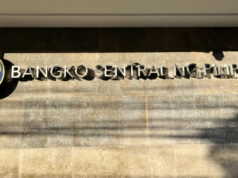Yields on government debt decline on BSP’s rate move
By Christine J.S. Castañeda
Senior Researcher
YIELDS ON government securities (GS) fell across-the-board last week following the central bank’s decision to cut benchmark interest rates by a quarter of a percentage point.
On average, debt yields — which move opposite to prices — went down by 35 basis points (bps) week on week, the PHP Bloomberg Valuation (BVAL) Service Reference Rates as of Aug. 9 published on the Philippine Dealing System’s website showed.
“The bigger week-on-week declines in local interest rate benchmarks (PHP BVAL yields) was largely brought about by the widely expected [25 basis point]-cut in local policy rates on August 8 after GDP (gross domestic product) growth eased to 5.5%…and after inflation further eased to 2.4% in July,” Rizal Commercial Banking Corp. (RCBC) economist Michael L. Ricafort said in an e-mail.
“PHP BVAL yields further eased towards the end of the week after BSP (Bangko Sentral ng Pilipinas) Governor [Benjamin E.] Diokno signalled another possible 0.25-bp cut in local policy rates and another possible one percentage point-cut in RRR (reserve requirement ratio) of banks as early as the next monetary policy-setting meeting on September 26,” he added.
Meanwhile, in a separate e-mail, a bond trader said: “Yields continued to fetch lower after the People’s Bank of China fixed the yuan significantly lower [last] week, signalling to markets that China will utilize the yuan against any untoward actions from the United States.”
“Consequently, the said action prompted the US Treasury Department to label China as a ‘currency manipulator.’ Both retaliatory actions had resulted in further escalation of current tensions between the two major economies,” the bond trader added.
On the local front, the bond trader said: “[M]arket participants remained anchored on expectations of a 25-basis-point BSP policy rate cut, which the local central bank delivered despite some expectations of a stronger cut following the release of weaker-than-expected second-quarter Philippine GDP growth report.”
The BSP Monetary Board decided in its fifth review for the year to cut key policy rates by 25 bps, bringing the overnight reverse repurchase rate to 4.25% and the overnight deposit and lending rates to 3.75% and 4.75%, respectively.
The Monetary Board also decided to cut its inflation forecast for the year to 2.6% from the downward-revised 2.7% adopted in its June 20 review. Next year’s forecast was also revised to 2.9% from three percent previously.
The BSP’s policy-setting body also gave its first forecast for 2021: 2.9% with a tilt “somewhat to the downside” due to prospects of slowing global growth.
Meanwhile, in an interview aired over ABS-CBN News Channel on Friday, BSP Governor Benjamin E. Diokno said another cut in banks’ RRR “can take place some time next month.”
The BSP chief said he is committed to paring the RRR down to “single-digit level” before he ends his term in July 2023.
Hours before the Monetary Board’s policy meeting for the year, the Philippine Statistics Authority (PSA) reported that the economy expanded at its slowest pace in 17 quarters in the April-June period due lower private investments and tempered household consumption and government spending.
GDP grew by 5.5% in the second quarter, slower than the first quarter’s 5.6% and the 6.2% logged in the same period last year. The second-quarter turnout was the slowest expansion since the 5.1% recorded in the first quarter of 2015 and was also lower than the 5.9% median estimate in BusinessWorld’s poll of 15 economists and institutions.
GDP growth averaged 5.5% last semester, slower than the 6.3% in 2018’s first half and the 6-7% target set by the government for 2019.
Separate PSA data showed headline inflation slowing to 2.4% last month, down from 2.7% in June and 5.7% in July 2018. The latest result matched the 2.4% reading in July 2017 and was also the slowest since the 2.2% logged in December 2016.
The July headline figure fell within the Bangko Sentral ng Pilipinas (BSP) Department of Economic Research’s 2-2.8% estimate for the month and matched the median in BusinessWorld’s poll of 18 institutions.
The latest reading brought year-to-date inflation to 3.3%, past the midpoint of the BSP’s 2-4% target range for the year and above the 2.7% full-year forecast average for 2019.
At the secondary market last Friday, yields were lower than week-ago levels across-the-board. The 91-day Treasury bill went down by 44.3 bps to yield 3.375%. The 182- and 364-day debt papers likewise declined by 44.3 bps and 43.2 bps, respectively, to fetch 3.603% and 3.719%.
Rates of the two-, three- and four-year bonds also went down by 45.5 bps (3.857%), 46.3 bps (3.960%) and 41.8 bps (4.063%), respectively. Yields on the five- and seven-year debt papers likewise dropped 34.4 bps (4.159%) and 22.3 bps (4.303%).
Yields on the 10-, 20- and 25-year notes also went down by 20.8 bps, 21 bps and 21.2 bps, respectively, to end at 4.372%, 4.7% and 4.697%.
For this week, RCBC’s Mr. Ricafort said: “The underlying easing trend in Philippine interest rate benchmarks that have been ongoing for most weeks for more than three months already or since May 2019 could still continue especially if the long-term interest rate/bond yield benchmarks in the US and other developed countries continue to ease, largely brought about by the escalation of the US-China trade war.”
For the bond trader: “Local yields might move with a downward bias [this] week, as bets of weaker data on Eurozone GDP and Chinese retail sales might further ignite concerns on slowing global growth and fuel views of more easing moves from local and major foreign central bank.”
“Yields might also fall following the recent BSP policy rate cut and continued safe-haven buying amid escalating US-China trade tension,” the bond trader added.



